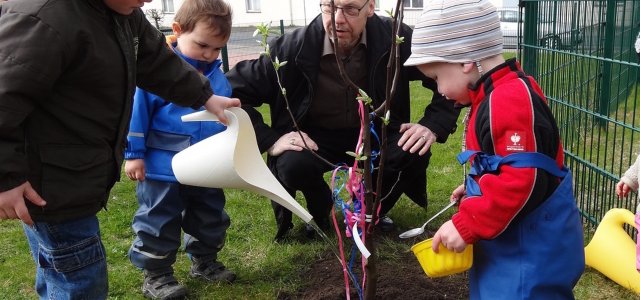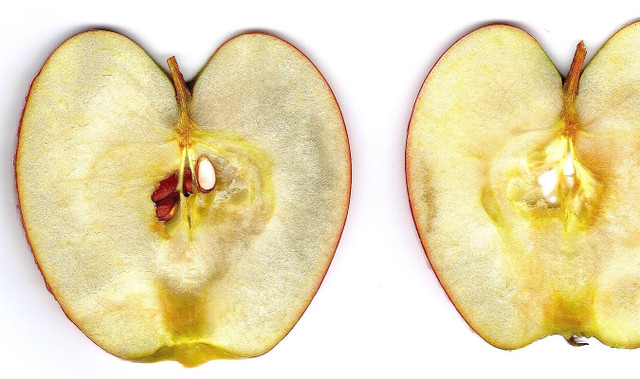
Planting your own apple tree – a dream of many garden owners. With the right location and a little care, he soon rewarded with juicy apples.
Contents
Planting an apple tree: Which variety is useful?
The Romans already cultivated six different apple varieties. Today, there are an estimated 30,000 varieties worldwide, of which around 2,000 are in Europe. Many hobby gardeners today like to reach for old varieties – because the old apple varieties are hard to come by in the supermarket.
But not every variety is suitable for the regional climate. Many old apple varieties are also susceptible to fungal diseases. You can find out which apple tree variety is best suited to your garden by asking your local fruit and gardening association. The experts usually know best which varieties produce good yields while being as disease resistant as possible.
Recommended apple varieties include:
- Retina
- Rebella
- Rewena
- Boskoop
Apple tree planting made easy
Planting an apple tree can be a rewarding and fruitful endeavor, but it’s essential to pay attention to various factors to ensure the tree’s health and productivity. Here’s what you need to watch out for when planting an apple tree:
- Variety Selection:
- Choose the right apple variety for your location and climate. Apple trees have different chilling requirements, and some varieties are better suited for specific regions. Consult with a local nursery or agricultural extension office to select a suitable variety.
- Location:
- Sunlight: Apple trees require full sun, typically 6-8 hours of direct sunlight daily. Select a planting site with ample sunlight to encourage fruit production.
- Soil: Apple trees prefer well-draining soil with a pH of around 6.0 to 7.0. Conduct a soil test to assess the pH and nutrient levels, and amend the soil as needed.
- Spacing:
- Proper spacing is crucial to allow for good air circulation and prevent overcrowding. Dwarf apple trees should be spaced about 8-10 feet apart, while standard-sized trees should have 15-20 feet between them.
- Planting Timing:
- Plant apple trees in the late winter or early spring while the tree is still dormant. This allows the tree to establish its roots before the growing season.
- Planting Depth:
- When planting, make sure the graft union (the point where the apple tree is grafted onto the rootstock) is above the soil line. Planting too deeply can hinder the tree’s growth and cause it to decline.
- Support and Staking:
- Young apple trees may need support to remain upright in strong winds or heavy rain. Stake the tree securely without damaging the roots. Check and adjust the stakes as needed during the tree’s early years.
- Watering:
- Provide consistent and deep watering during the first few years of the tree’s growth. After that, maintain a regular watering schedule to keep the soil evenly moist. Avoid overwatering or allowing the tree to sit in waterlogged soil.
- Mulching:
- Apply a 2-4 inch layer of organic mulch, such as wood chips or straw, around the base of the tree. Mulch helps conserve moisture, suppress weeds, and maintain more even soil temperatures.
- Fertilizing:
- Perform a soil test to determine the tree’s nutrient requirements. Apple trees typically benefit from a balanced fertilizer application in the spring. Avoid excessive nitrogen, which can lead to excessive vegetative growth at the expense of fruit production.
- Pruning and Training:
- Regular pruning is essential to shape the tree, remove dead or diseased branches, and improve air circulation. Follow proper pruning techniques and timing to ensure healthy growth and maximize fruit production.
- Pest and Disease Management:
- Be vigilant for common apple tree pests like aphids, codling moths, and apple maggot. Implement appropriate pest control measures, including organic and chemical options, as needed. Watch out for signs of diseases such as apple scab and fire blight, and take prompt action to manage them.
- Thinning Fruit:
- To improve fruit quality and prevent limb damage from overbearing, thin the apple tree’s fruit in early summer, leaving an appropriate distance between apples.
- Harvesting:
- Harvest apples at the right time based on the variety. Different varieties ripen at different times, so it’s important to know when to pick them for the best flavor and texture.
By being attentive to these factors and providing proper care, you can enjoy the benefits of a healthy and productive apple tree in your garden or orchard.
Once you’ve decided on an apple variety, it’s a good idea to research the specific planting tips. These can vary depending on the variety. In general, you should pay attention to the following when it comes to soil and location:
Find a sunny spot to plant the apple tree. Although apple trees will grow in the shade, a sunny location will produce more fruit.
The soil should be free of waterlogging, as apple trees have very fine and sensitive roots. The apple tree also dislikes heavily loamy soils. A loose humus soil is better.
The best time to plant a young apple tree is in the fall. With luck, it will bear its first apples next year.
Instructions:
- Dig the planting hole generously so that the roots have room to grow.
- Enrich the soil with some compost.
- The distance to neighboring trees or to house walls should be several meters. This will give the roots and later the crown enough space.
- Place the root ball in the planting hole.
- Fill it with soil.
- Now water vigorously.
Planting apple tree from an apple core

In principle, you can also grow an apple tree from an apple core and then plant it. However, the seeds are equipped with natural germination inhibitors to survive the cold winter. So, in order for the seeds to germinate, you need to pre-treat them first:
- Place the apple cores between two damp layers of paper in a container.
- Store the container with the seeds in the refrigerator for about three weeks.
- After three weeks, the first seedlings should become visible.
- Plant the seedlings individually in larger pots – about one centimeter deep.
- It is important in the first phase to water the seedlings abundantly. The location should be warm and bright.
Apple tree care and pruning – the right way!
After you plant the apple tree, winter pruning should become routine from the second year. Pruning back branches will provide a larger apple crop the following year. Remove primarily shoots and branches that get in each other’s way. In particular, you should cut off crossing, diseased, dead, damaged and dense branches.
Which apple variety did you choose? We look forward to your experiences in the comments!

